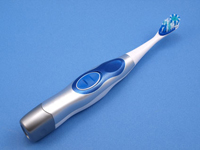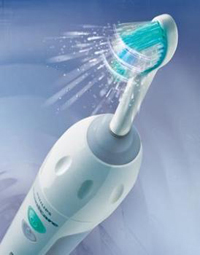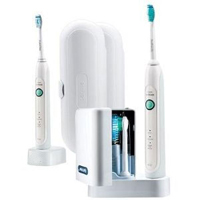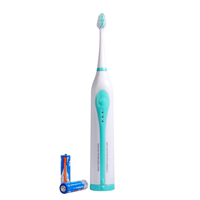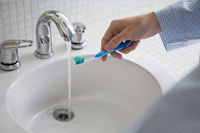
| | Electric toothbrushes were first introduced in the U.S. in 1960 by a company called Squibb, and marketed under the name Broxodent. Today, there are dozens of different brands available, with a myriad of features, including re-chargeable batteries, compact designs, and bristles built for optimal cleaning. But a toothbrush is worthless if you brush incorrectly. |
Why Power Toothbrushes Are Better?
Simply stated, rechargeable electric toothbrushes provide superior plaque removal to regular manual toothbrushes. And because they provide the brushing action for you, many people find using power toothbrushes easier than using regular manual ones.
| According to a 2005 independent study, Brushes that worked with a rotation oscillation action removed more plaque and reduced gingivitis more effectively than manual brushes in the short and long-term. Whereas you have to move a regular manual toothbrush back and forth along your teeth, power toothbrushes provide the cleaning action for you. That means you need only guide it along the surfaces of your teeth. Once they get the hang of it, many people find this method of brushing easier. Likewise, people with arthritis or other similar conditions may find using a power toothbrush less painful. Power toothbrushes may also help kids brush their teeth more effectively, but sure to check the age recommendations on an electric toothbrush before letting your child use it. | |
Electric Toothbrush Types
With so many electric toothbrush types available on the market, it's often difficult to select the right toothbrush for your own needs. First, let's distinguish between electric toothbrushes and battery-powered toothbrushes.
| | Rechargeable Electric Toothbrush A rechargeable electric toothbrush, also known as a "power toothbrush" is the kind you plug into the wall to recharge, keeping the handle and replacing the brush head every three months or so. Rechargeable electric toothbrushes differ among the kind of cleaning technology they use, such as oscillating-rotating (3D Cleaning Action) or sonic technology.
|
| | Battery Power Toothbrush Those who want a dose of power but are weary of electric toothbrushes may like battery power toothbrushes. Like electric toothbrushes, battery power toothbrushes are sometimes simply called “power toothbrushes” due to their use of a AA battery. While similar in design to regular manual toothbrushes, battery power toothbrushes have just enough vibration to add some extra cleaning action.
|
| Once you decide whether you want a rechargeable electric or battery power toothbrush, your next decision will likely be based upon the features of each type of brush. |
Practice Proper Toothbrushing
| No matter your toothbrush preference, good technique makes the difference in your oral health. You need to brush a minimum of twice a day, for about two minutes each time, every morning and at night before you go to bed to avoid food sitting on your teeth and gums for long periods of time. Quality is as important as quantity when it comes to brushing. Here are tips for good toothbrushing technique: | |
| 1. Angle the brush at about a 45 degree angle up onto the tooth and into gum line. |
What's the biggest brushing mistake people make? Just swishing the toothbrush around without making sure to reach all areas of the mouth. People tend to brush their teeth too fast, and end up missing spots, especially in the back of their mouth. And that's a problem because plaque is full of harmful bacteria and it can lead to gum disease and cavities.
Are there any steps you can skip if you're in a rush? It's OK to occasionally skip a brushing, since it takes about 24 hours for plaque and bacteria to form on your teeth. But you should to brush twice a day, and floss once.
What about those Y-shaped floss picks now available? They might it easier to reach those hard-to-reach spots between teeth. And if they make it more likely to floss, they might be worth it. But we did the math, and floss picks cost about 4 cents apiece, about twice as much as regular dental floss costs per use.
Written by Nicolas Yang
